

The Boom of Yuru Kyara
|
Being the birthplace of the famous cat mascot Hello Kitty, Japan is no stranger to cute characters. In fact, you may notice the strong presence of adorable and unique mascots when you visit any region of Japan, known as “yuru kyara”. The term was coined by illustrator Jun Miura, with “yuru” meaning “loose” which paints a gentle and laidback image, and “kyara” deriving from the loanword for “character”. According to Jun Miura, a yuru kyara should possess these three characteristics: convey a strong message of love for its hometown or local region, have unique or awkward movements or behaviour, and be laidback and lovable.
How did yuru kyara gain popularity and spread rapidly across Japan? One significant incident was a mascot design competition held in 1998 by the Japan Broadcasting Corporation NHK in celebration of their 10th anniversary, and the winning entry was Domo-kun. As the official mascot of NHK, Domo-kun was featured in short stop-motion sketches and the brown mascot soon earned fans both in Japan and overseas. Domo-kun joined the ranks of more polished mascots like Hello Kitty, Doraemon and Pikachu, to become one of the earlier mascots to shoot up in popularity across the globe, which certainly paved the way for the boom of yuru kyara. 2008 saw an explosion of interest in yuru kyara and was nominated as Japan’s trendy word of the year, as local governments and other organisations began to create their own representative character to use for public relations and boost regional development. Often, the mascots look simple or even unpolished. However, their relaxed appearances appeal to people, especially considering that some of them are designed by ordinary citizens. Sometimes there are also difficulties in perfectly rendering their design into a life-sized costume. This imperfection further makes them “looser”, and presents an interesting contrast to the meticulous character designs seen in animation or video games. Another interesting feature is the play on words when it comes to naming yuru kyara. For example, Kumamon is the representative mascot of Kumamoto prefecture, and resembles a black bear, though his management insists otherwise. The name derives from “Kuma” in “Kumamoto” which means “bear”, and “Mon” means “person” in local dialect. Another example is Bunkacky, or Bunkakki, which was the mascot of the National Culture Festival held in Hiroshima in 2000 and is now Hiroshima City’s culture mascot. It resembles an oyster with a maple leaf, and the hiragana character “ひ” (hi), and its name derives from “Bunka” which means “culture”, and “Kakki” which means oyster. Some yuru kyara even expand their circle with similar-looking family or friends. For example, the mascot characters of Miyazaki prefecture are three dog brothers. There is also an amusing example of Mican, the mascot of Ehime prefecture that resembles an orange and dog. Besides him, there is also Dark Mican who acts as his rival, as well as Komican and KoDark. The buzz around yuru kyara set the stage for the first ever Yuru Kyara Grand Prix in 2010, where the public could vote for their favourite mascot. Hikonyan, a maneki neko wearing a red samurai helmet, won the competition in 2010, while Kumamon won in 2011. The former was created to commemorate the 400th anniversary of the construction of Hikone Castle in Shiga prefecture, and plays a significant role in attracting visitors to by making rounds around Hikone Castle every day. The latter started out in Kumamoto prefecture, but can now be found everywhere in Japan. In the following year of its contest win in 2012, sales for Kumamon-related merchandises reached an outstanding sum of 29.36 billion yen. Kumamon even received the Good Design Award from the Japan Chamber of Commerce and Industry in 2013. While the Yuru Kyara Grand Prix has unfortunately ended in 2020, the overwhelming popularity and influence of these yuru kyara remain undeniable, with some having thousands of followers on their social media accounts. Do you have a favourite yuru kyara? |
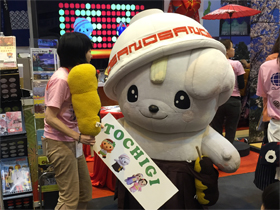 SJ50 Matsuri © JCC 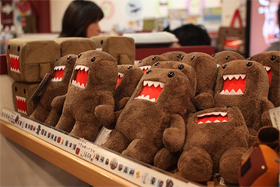 Domo-kun © Yi Chen, CC BY 2.0, via Wikimedia Commons 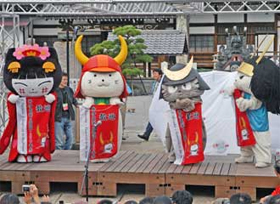 The Yuru Kyara Festival in Hikone © Hikone City, Shiga Prefecture 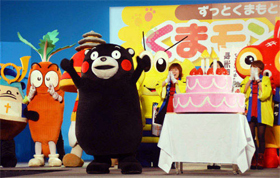 Kumamon © Kyodo News Service 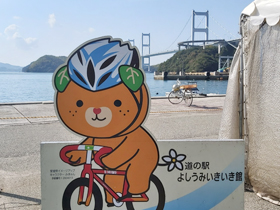 Mican © JCC 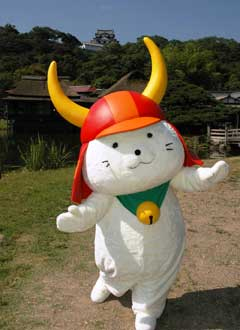 Hikonyan © Hikone City, Shiga Prefecture |
Resources
|
“Mascots Making Waves: “Loose” Characters Employed to Boost Local Development”. 2009. Web Japan. https://web-japan.org/trends/08_culture/pop090327.html. “Kumamon – Japan’s Most Popular Bear”. 2013. Web Japan. https://web-japan.org/trends/11_culture/pop130812.html. Occhi, Debra J. 2020. “Yuru Kyara”. Japanese Media and Popular Culture. https://jmpc-utokyo.com/keyword/yuru-kyara/. Low, Hana. 2021. “The Phenomenon of Mascot Culture in Japan: Yuru-Kyara”. Arigato Travel. https://arigatojapan.co.jp/the-phenomenon-of-mascot-culture-in-japan-yuru-kyara/. “みきゃんのかんづめ”. 2022. Ehime Prefecture. Accessed 25 July. https://www.pref.ehime.jp/h12200/mican-kanzume/index.html. |
|
Japan Creative Centre 4 Nassim Road, Singapore 258372 +65 6737 0434 / jcc@sn.mofa.go.jp https://www.sg.emb-japan.go.jp/JCC/ Nearest parking at Orchard Hotel & Delphi Orchard |
 |